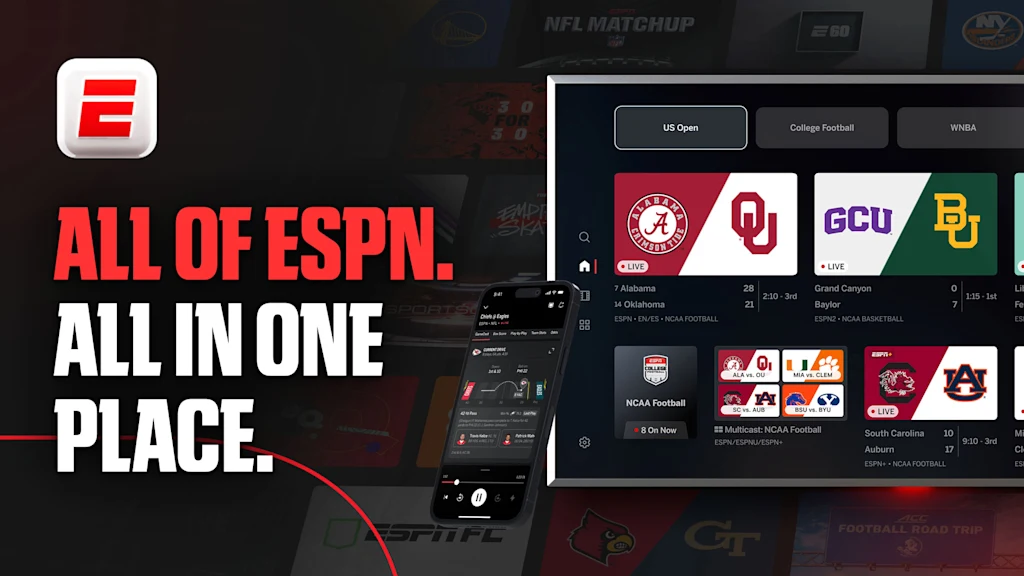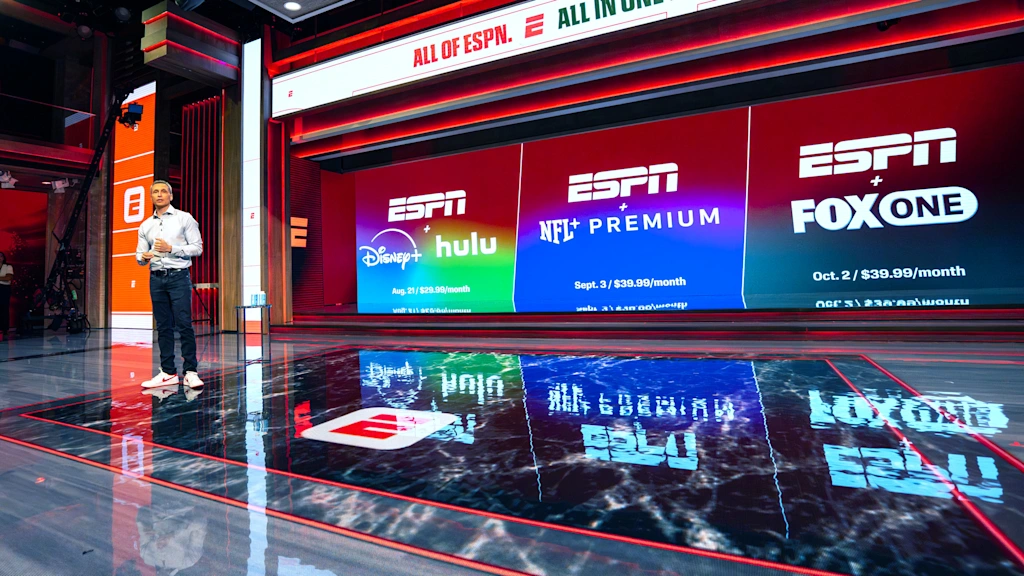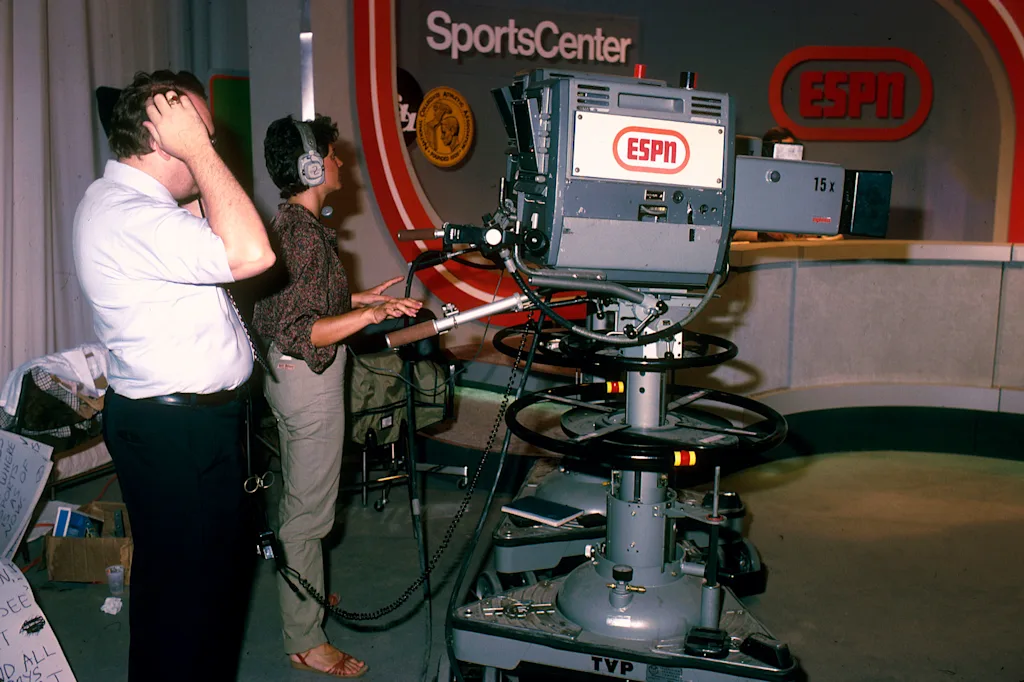CEOs rarely talk about plans that are a half-decade or more away from reaching reality. Yet way back in 2015, Disney CEO Robert Iger confirmed the company would eventually offer ESPN as a direct-to-consumer service. It would be an epoch-shifting moment for a channel that has been a cornerstone of pay TV in its traditional form for decades, and Iger said it wouldn’t occur until at least 2020.
Ultimately, this retooling took a full decade—a period during which Iger retired and unretired. But the moment he said would come has arrived. Starting today, you can get full-blown ESPN in stand-alone streaming form, available on connected TVs, phones, tablets, and computers. It’s the biggest inflection point for Disney’s direct-to-consumer video strategy since the company launched Disney+ in 2019.
“We believe that people should be able to subscribe to ESPN in whatever way best suits them,” says Adam Smith, named chief product and technology officer for Disney Entertainment and ESPN a year ago after over 20 years at YouTube and Google. “If they want to do it direct to consumer through us, if they want to buy it through a bundle, or if they want to just continue purchasing it through [a cable or satellite provider], that’s all great.”
What Disney is offering isn’t just the same familiar ESPN programming delivered over the internet. Instead, the company has taken its 47,000 live sporting events a year, spread out across 12 channels, and built a distinctly digital experience around them. That experience spans apps for connected TVs, phones, computers, and TVs, sometimes intermingling them. It also flows into Disney+, where ESPN’s motherlode of content could provide a competitive advantage over Netflix, HBO Max, and other streamers that offer only a dollop of athletics by comparison.
It’s no shocker that Disney frames ESPN’s new streaming presence as being about customer choice, not the brand being any less relevant as part of a cable or satellite package. Historically, the carriage fees the company charged companies such as Comcast and DirecTV—reportedly around $9.42 per pay-TV subscriber, the highest figure in the industry—were a powerful, dependable revenue stream. But as traditional TV has lost eyeballs to a bevy of newer ways for people to entertain themselves, ESPN’s old business model has faced secular decline. Disney has had to manage that descent while coming up with something that can find a place in sports fans’ streaming budgets.

Disney’s desire to provide options is reflected in the numerous ways consumers can get access to the new service. Officially, it’s $30 a month. But anyone who’s already entitled to ESPN as part of a TV package will get the streaming version at no additional charge. And Disney—which has long priced its services to nudge consumers toward bundles—is also offering ESPN plus ad-supported versions of Disney+ and Hulu at the same $30 a month for the first 12 months. It’s also teaming with Fox to sell a $40 bundle including ESPN and a new sports/news/entertainment service called Fox One. A different $40 bundle offers ESPN and NFL+ Premium. (Disney recently agreed to acquire the NFL Network in return for the NFL getting a 10% stake in ESPN.)

Even after so many years of contemplating the eventuality of ESPN in streaming form and then actively building it, Disney knows only so much about what the brand’s future might look like. As technology continues to permit new scenarios, sports fans’ expectations and preferences are subject to further change: “We are navigating through some storms here,” ESPN chairman Jimmy Pitaro tells Fast Company editor in chief Brendan Vaughan in an exclusive interview. But with its new service, the company has a tapestry for further refinement, experimentation, and expansion.
“It really is a product that you’re going to see continue to improve with time, as we get more data and understand usage and the ways that consumers are most interested in interacting with ESPN in a direct-to-consumer fashion,” says Smith.
Same apps, more ESPN
Though Disney didn’t exactly rush to make ESPN’s crown jewels available over the internet, it already has the largest digital footprint of any sports media brand. Between its own platform, YouTube, and social media, it reached 193.6 million people—almost 70% of U.S. adults—in June, according to Comscore. The company also has eight years of streaming experience under its belt thanks to ESPN+, its digital-only brand extension, which will roll up into the new service. (It will also remain separately available as the core of ESPN Select, a slimmed-down $12/month tier.)
Critically, Disney isn’t launching a new ESPN streaming app and then trying to convince people to install it. Instead, it’s giving the ESPN apps that already have 30 million active users a lot more, well, ESPN. Rather than supplementing live event coverage, they’ll incorporate and enhance it.
Smith emphasizes that particular care has gone into the ESPN app that comes closest to mirroring the way people have traditionally watched sports: the one for connected TVs. “A lot of folks just want to jump live into the game,” he says. But rather than simply dumping them into the action in progress, the app offers a feature called “Catch Up to Live” that summarizes what’s happened so far. Multiview capability lets viewers keep tabs on up to four streams at once—an entirely real-world scenario given that ESPN may be showing up to 200 events on any given weekend.

Once someone is tuned into a particular stream, the app can offer them access to data that goes far beyond the overlays on a traditional broadcast. “It’s almost like being in the game with a Jumbotron,” says Smith. “It allows you to see like who’s on the court, who’s performing well, any kind of stats that we get made available to us or we’re able to gather.”
In 19 states and Washington, D.C., ESPN offers a wagering service called ESPN Bet, provided through a partnership with Penn Entertainment. By linking their ESPN and ESPN Bet apps, fans with money riding on games will be able to see their live and settled wagers onscreen alongside the events in question. Tens of millions of people who compete on ESPN’s fantasy sports platform will also get in-app integrations: “If your league’s coming down to the wire and Monday Night Football matters, you’ll able to have your fantasy football team showing up right there on the right hand panel and track your odds of actually pulling it out,” says Smith.
Then there’s merch. ESPN is integrating shopping opportunities into relevant events using an onscreen QR code, which Smith says makes for “a frictionless user journey.”
Phone, meet TV
For years now, the fact that someone has been watching sports on TV hasn’t prevented them from scrolling away on their smartphone at the same time. ESPN is formalizing that dual-screen experience with a feature called Stream Center. It allows viewers to control the ESPN connected TV experience from their phone as well as check out other scores and news. And it syncs the two screens so that nobody stumbles across spoilers on the phone for an event they’re watching on the big screen.
Along with building digital experiences around live sports events, ESPN is using its digital platform to share news and highlights. Here it can atomize its content and reassemble it algorithmically, taking it far afield of anything possible on broadcast TV.
For example, a TikTok-esque feature called Verts offers a feed of quick, vertically oriented videos—the stuff ESPN already shares on social networks, but inside the company’s own app. SportsCenter for You, a custom news report inspired by ESPN’s best-known show, uses an AI-generated voiceover based on a real ESPN broadcaster—Christina Alexander, in the case of the demo I got—to narrate a custom collection of news items. ”We want to make effectively millions of SportsCenters, each uniquely tailored to the interest of the individual,” says Smith.

While much of ESPN’s new digital experience will be unique to its own apps, the full gamut of ESPN programming will also be available in Disney+. That wasn’t just a matter of sticking a new tile in the Disney+ interface along with the existing ones for Marvel, Pixar, Star Wars, and other fare. The company has spent years merging the technical underpinnings of ESPN, Disney+, and Hulu, each of which began with a different origin story and weren’t initially designed with compatibility in mind.
That long-term project is what lets consumers watch what they’d like where they’d like. In late 2023, for instance, the company began letting people watch Hulu content in Disney+. ESPN+ content followed a year later. Even now, putting ESPN inside Disney+ is a complex enough feat that it won’t be available on every platform on launch day.
Integrating Disney’s streaming offerings has been “a big, heavy lift, from the video backends to the new player to the ads,” Smith told me. But it’s essential to the company maximizing the profit potential of its streaming business. For instance, only recently has Disney unified the ad-buying side of things enough for marketers to easily purchase campaigns across Disney+, ESPN, and Hulu.
Technical streamlining also facilitated Disney’s recently announced decision to phase out Hulu’s stand-alone app in favor of the brand existing within Disney+, a move that solidifies Disney+ as the company’s overarching streaming destination and might unlock billions in cost savings. Which raises a question: Is there any chance that ESPN’s new digital incarnation is not its destiny but rather a way station on the road to full integration into Disney+?
“You never say never,” allows Smith. But, he quickly adds, “We believe that we serve sports fans really well through the ESPN app, through the mix of video programming, data, scores, news—that there’s a use case for that.” Fans have been patiently awaiting that experience ever since Iger first teased it. Now they get to decide if Disney has delivered.
Login to add comment
Other posts in this group

AI usage has been deemed by some to be an inevitablity. Many recent he


China has been expanding the use of digital currencies as it promotes wider use of its yuan, or renminbi, to reflect its status as the world’s second-largest economy and challenge the overwh

Welcome to AI Decoded, Fast Company’s weekly newsletter that breaks down the most imp

Ever wonder how much energy it takes when you ask an AI to draft an em

It’s one of the great questions of our modern age: How does Sweetgreen lose money selling $14 (and up!) fast casual salads and bowls? And not just a little money but $442 million in the last three

Throughout 2023, the Biden administration persuaded a group of AI comp
